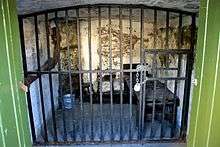Single-celling

A prison cell designed for a single inmate
Single-celling is the practice of assigning only one inmate to each cell in a prison. John Howard has been credited as establishing the practice of single-celling in the United Kingdom and, by extension, in the United States.[1] In 1957, only 15 prisons in the United States practiced single-celling exclusively while 41 prisons employed it with a portion of their cells and 44 housed multiple prisoners in all of their cells.[2] Critics of single-celling suggest that the practice imposes psychologically harmful isolation on inmates, while advocates argue that single-celling alleviates many of the inmates' discomforts.[3]
See also
References
- ↑ Michael Sherman; Gordon J. Hawkins (1983). Imprisonment in America: Choosing the Future. University of Chicago Press. pp. 32–33. ISBN 0-226-75280-1.
- ↑ Proceedings of the Annual Congress of Correction of the American Correctional Association. American Correctional Association. 1957.
- ↑ Alexis M. Durham. Crisis and Reform: Current Issues in American Punishment. Jones and Bartlett Publishers. p. 107. ISBN 0-316-19710-6.
This article is issued from Wikipedia - version of the 8/27/2016. The text is available under the Creative Commons Attribution/Share Alike but additional terms may apply for the media files.